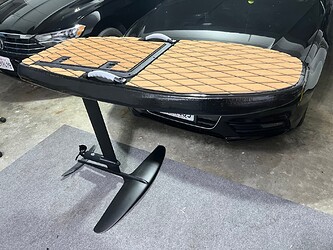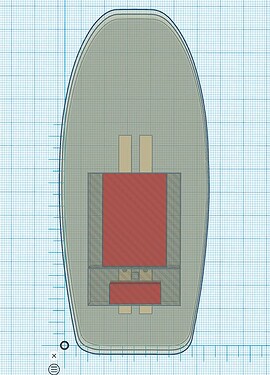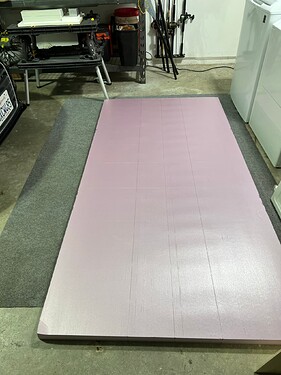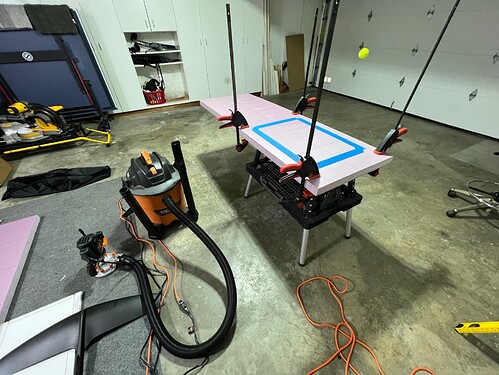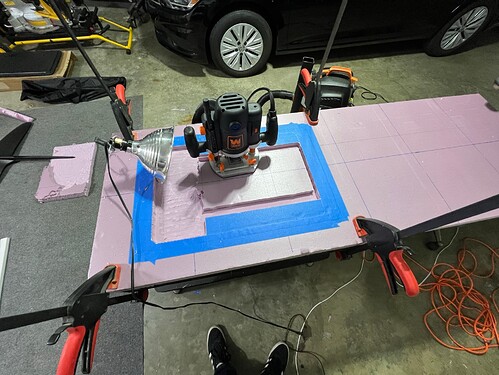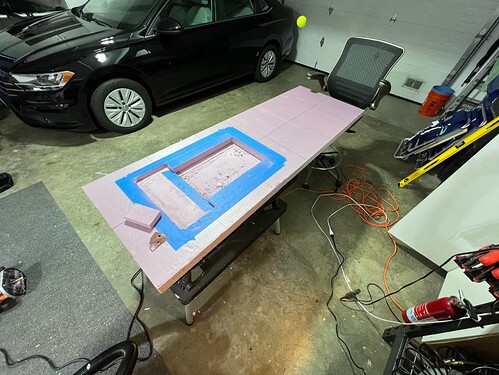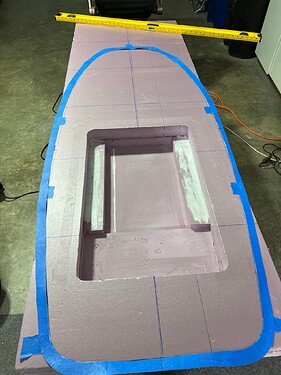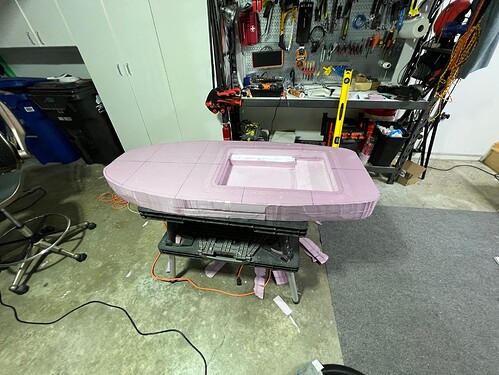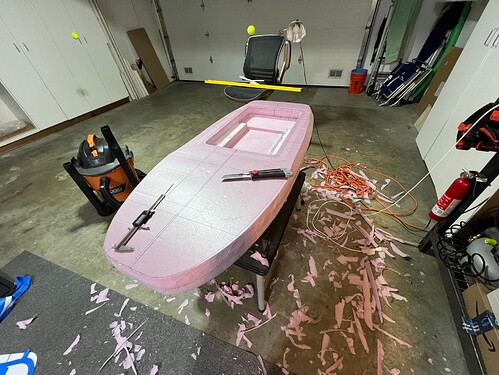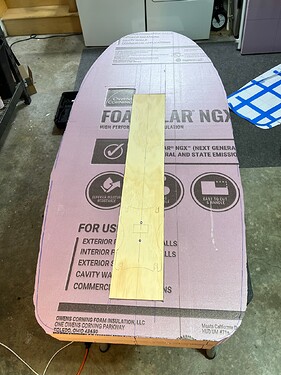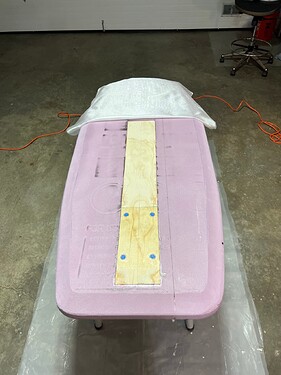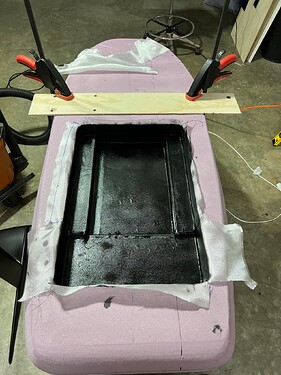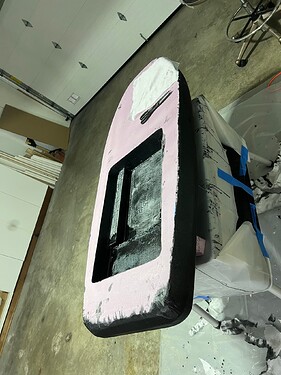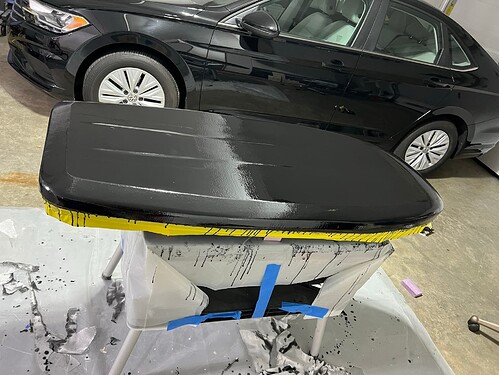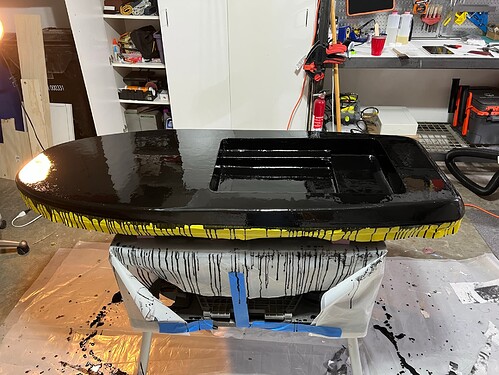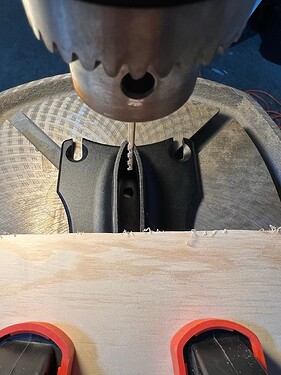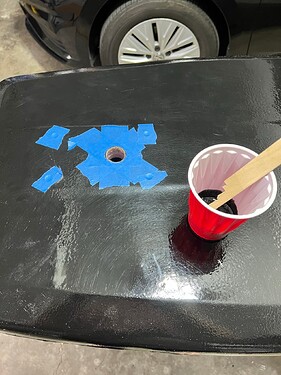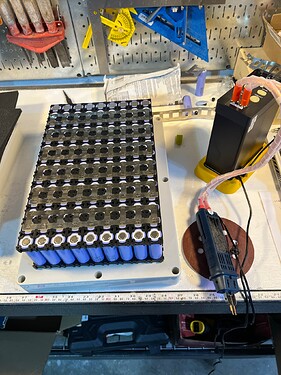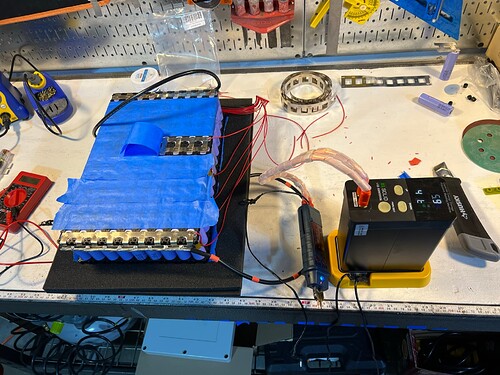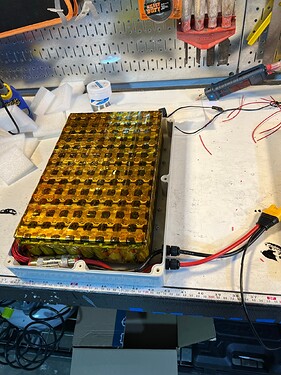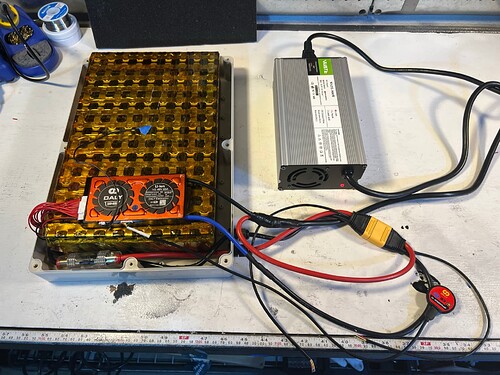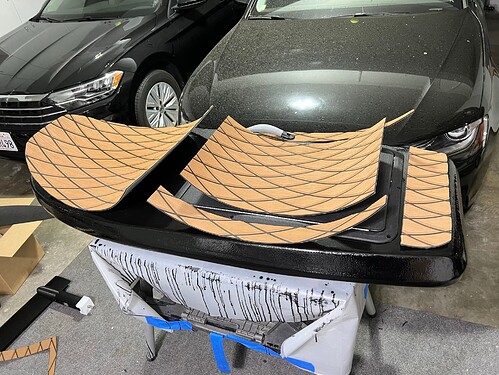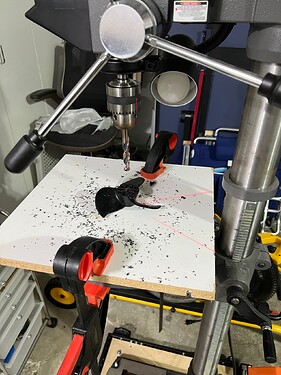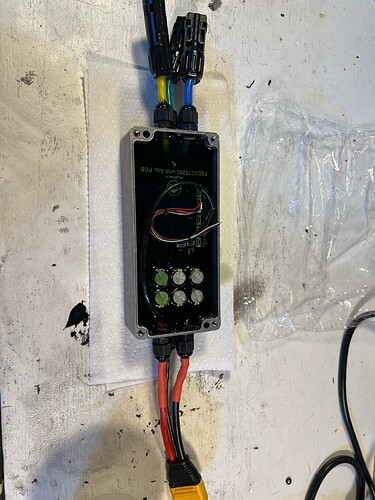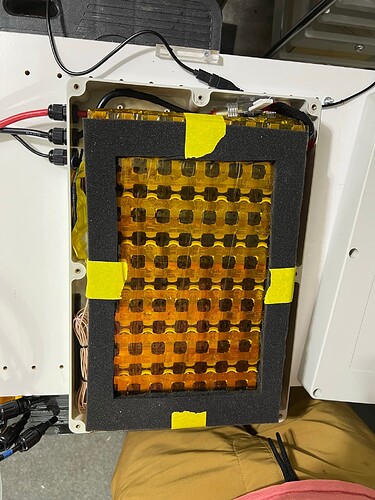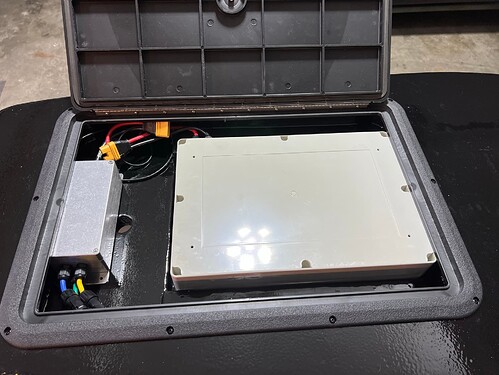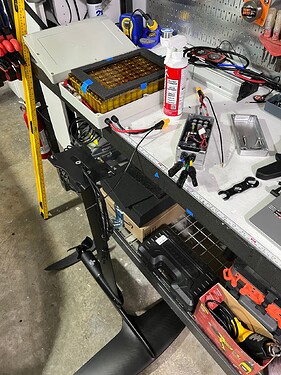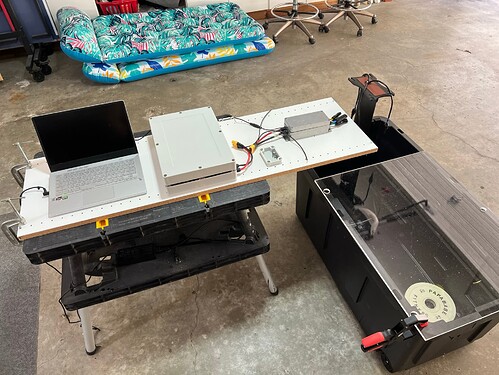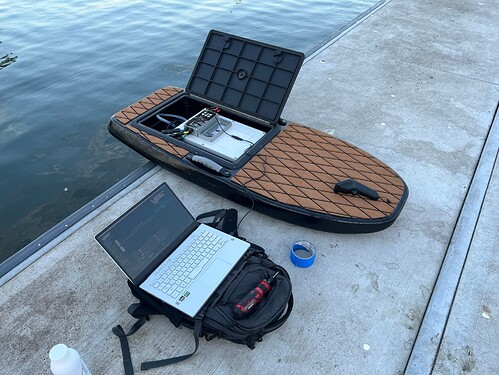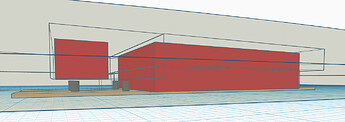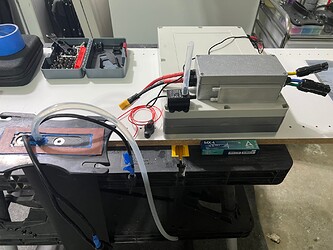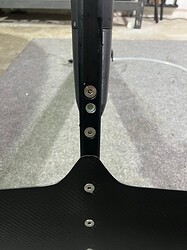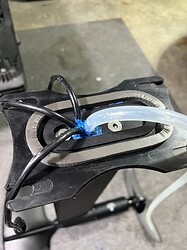First - Thanks to all those that have come before and the huge amount of knowledge this community has put together to help inform builds like this. I seriously couldn’t have done this without hours and hours of reading through foilzone.
I’m about two months into my build and am finally getting around to collating all of the information, photos, and things I’ve learned along the way. There is a lot to post and add notes to so this will likely take a few days to bring up to date and get all my thoughts down.
Build Summary:
- 4’8" x 24" x 4" Custom Fiberglass board
- Flipsky 65161 120kv, 75200 Alu ESC, and VX3 Remote
- 14S9P 21700 Battery: 48V, 35AH, 315 Max Amps (lol)
- Aliexpress wing, mast and mastplate.
VESC 5.1 Config File: Placeholder to remind me to upload it
Warning use at your own risk. I had issues with VESC 5.2 firmware cutting out under high load so I went with 5.1, this file includes my parameters for 14S9P, Current / Voltage Limits, Throttle etc.
Major Build Components
1x 4x8’ 2" Formular NGX 250 XPS Board: $50
8x Yard 4oz S-2 Fiberglass Cloth: $103
1x 96oz Marine Epoxy Resin Kit: $110
1x AliExpress Mastplate, Mast and Carbon Wing: $350
126x Samsung T40v3 21700 Cells: $504 – In retrospect these cells are probably overkill
1x Daly 60A BMS: $61
1x Wate 58.8V 15A Charger: $95
1x Flipsky 75200 ESC: $205
1x Flipsky VX3 Remote:$105
1x Flite Propeller: $35
1x Flipsky 65161 120kv : $452
1x Aluminum IP68 ESC Enclosure:$25 – It took a huge amount of time to find a IP rated enclosure that perfectly fit the 75200 - Also available through Polycase as the AN-21
1x CorrosionX Dielectric Liquid: $25
1x Roll of EVA Foam: $65
1x Amass AS150U Pigtails: $22 / pair
1x IP68 Solar Panel Connectors 8awg $15
1x IP67 ABS Junction Box: $50
1x DPI Marine 16x24 Hatch: $115
Tools:
1x 12kw Spot Welder: $300
1x Rivnut Tool: $40
1x Hydraulic Crimper w/ copper sleeves for the 8awg connections: N/A Already Owned.
1x Ender 3 Pro 3d Printer: $ N/A Already Owned
1x Orbital Sander: $ N/A Already Owned
1x Drill Press: $ N/A Already Owned
Bits and Parts
1x Loctite Marine Fast Cure Adhesive $20
1x Gorilla Construction Adhesive: $10 – This was to adhere the layers of XPS. Youtube says this is the best adhesive for the job
1x 304 Stainless M8 Rivnut Set: $10 – For attaching the mastplate to the board
1x 4x35mm 304 Stainless Dowel Pins: $9 – Used to
1x Roll of 21700 .2mm 2P Nickel Strip
3x Epoxy Brushes: $5
3x Epoxy Squeegee: $5
1x Epoxy Pigment: $15
1x Pack of PG7 Glands: $10
Lots of Masking Tape
Lots of Nitrile Gloves
Total Build Cost: ~$2,787 USD
CAD Mockup
I used TinkerCAD to confirm fitment of the different components prior to starting work on the build. Everything was shown to fit but was very tight, down to only a couple of millimeters for several tolerances.
The main difference in the final design versus what is seen here is I used a single plywood reinforcing strut on the base of the board versus the two separate pieces seen here
Nose contour not included
Board Build
It all started here with a big piece of XPS insulation foam. Getting this home on top of my car proved to be quite the interesting experience. Turns out lightweight foam doesnt like to be strapped to the roof.
The basic idea having done quite a bit of modeling in tinkercad was to split this 4’ wide sheet into two 2’ segments, which would then be laid on top of each other to give a total depth of 4". The boards were routed separately before being glued up so I could get to the required depth.
The next set of steps were to cut the profile of the board using a hot wire and start to give it some contouring. To get the basic shape I drew a a profile to scale in Illustrator and then printed it on tiled 8.5x11"s that were taped together to give me a good guide line that ultimately became the blue shape seen in the photos.
With the 3.75" of depth I needed for the battery compartment, there was only .25" of foam below where I was planning to put a 40 pound battery. Even with multiple layers of fiberglass I wasnt sure that it would hold. To reinforce this area and provide an interface for the Rivnuts I routed a shallow cavity into which a plank of 1/8" plywood would be inserted.
In this image you can see where the rivnuts are located under blue painters tape to keep resin from getting into the threads.
Fiber glassing. This was my first time doing this, but all things considered I think it turned out pretty well. If I had it to do again I probably would have created a mold for the cavity and over-molded the complex contours to create a drop-in shell.
Drilling the holes for the motor wires in both the board and the mast plate. The hole through the board was fiber glassed as well.
Battery Build
Laying out the 2P connections
Blue tape to keep from shorting any connections while I was working.
Finished welding and kapton tape applied. The collector series connections feature 8AWG cable soldered to the nickel.
Test charging with the BMS and charger.
Misc Finishing
Laying out the EVA foam after cutting to shape. This came as a large roll but was fairly easy to cut using a razor
Drilling-out the Flite Prop to accommodate the 65161 shaft.
Electronics Finishing
Submerging the ESC in CorrosionX. This was my second attempt at this after the first ESC enclosure leaded profusely. For the second attempt I paid much more attention to creating clean holes in the aluminum and used a bit of gasket maker on each gland to help ensure it’s completely leak free.
One of the huge advantages of the AS150U pigtails is they conveniently have 4 small gauge wires to also carry a data signal. This happens to be the perfect number to allow the remote antenna to be moved out of the aluminum ESC enclosure and into the ABS battery box to improve signal. You can see some of that wiring tucked in the left side of the picture below.
Final fit of the battery and ESC.
Testing
Vesc initial setup and motor calibration. Huge success, no smoke ![]()
I ended up getting a 75 gallon storage container and building a mount for the mast so I could test the motor in-water without having to go to the marina. This helped me to refine my VESC settings and also evaluate ESC heat generation under load.
and finally where I was earlier today, testing in the marina. It took a while (and several faceplants into the water) to finally figure out that the VESC Absolute Maximum Current setting was causing an immediate drop in current to zero. I was hitting 90-95% max throttle and then all of sudden the motor would stop abruptly.
Hopefully a successful test flight coming soon!™
Thanks for stopping by.
